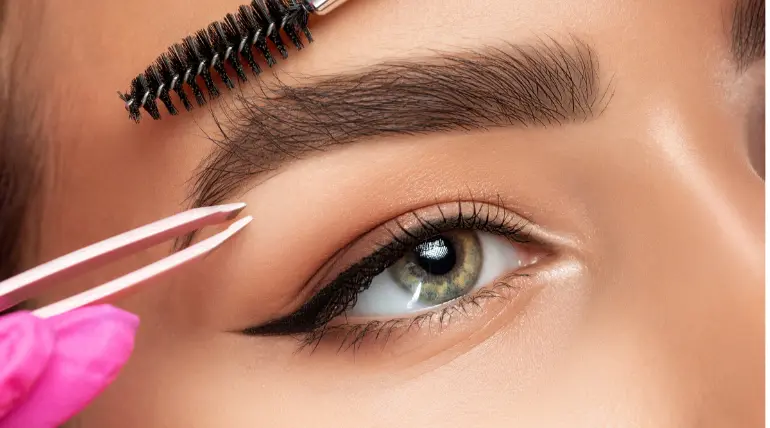
Unlike other beauty trends, eyebrow threading was not created with social media in mind, despite the fact that videos of the procedure have an ASMR-like sensation. This salon procedure eliminates extra hairs above and below your natural eyebrow contour. The results are red carpet-perfect without the discomfort of waxing or microblading.
If you’re looking for a novel way to reshape and groom your eyebrows, eyebrow threading is a good choice. Nothing compares to a professional treatment, even though do-it-yourself threading is growing in popularity (read this before trying!). Here are certain things you should know before setting up your first session that Instagram scrolling won’t tell you.
What Is Eyebrow Threading?
Although it might seem like a recent fad, eyebrow threading has been used for thousands of years in the Middle East and India! To quickly extract unwanted hair from the follicle, a single strand of cotton thread is twisted and rubbed over the hair.
With brow designs and trends constantly changing, threading is an excellent method to experiment or just clean up, shape, and define. Threading works well on your lips, chin, and peach fuzz on the side of your face in addition to your brows.
The Advantages of Eyebrow Threading
Of course, the quickness of the process is a significant advantage. There is no need to wait for the wax to cool or use depilatory treatments to destroy the hair. Threading is suitable for a wide range of skin types, especially those with sensitive skin or prone to breakouts. Here are some of its advantages-
- Precise Eyebrow Shaping
Unlike waxing, which eliminates a lot of hair at once, brow threading delivers unparalleled precision. The instrument itself, a thin, doubled thread, is the trick. This makes it possible for experts to precisely target individual hairs.
- Speedy Appointments
In comparison to other procedures like tweezing, which can be time-consuming and tiresome, eyebrow threading takes only 20 minutes on average.
- Ideal for Sensitive Skin
Brow threading is your new best friend if you’re worried with the idea of having red, irritated skin after hair removal. Threading is a far kinder alternative to waxing, which can cause pain on delicate skin.
- Long-Lasting Results
Prepare yourself for weeks of perfect eyebrows! Threading eliminates hair from the root instead of simply the surface for results that stay longer. Unlike shaving, which leaves stubble after a few days, threading keeps your brows looking perfect for up to five weeks.
- Prevent Premature Aging
For individuals who desire to keep their youthful appearance, brow threading has an unexpected advantage. Threading does not pull on the fragile skin surrounding the brows like waxing, which can lead to tension and drooping over time. This keeps your brows looking young and lifted by reducing the appearance of fine lines and wrinkles.
How to Thread Eyebrows at Home
Threading your eyebrows at home can be a convenient and cost-effective way to maintain your brows. Follow these steps for a precise and safe threading experience.
You Will Need:
- A 14-inch piece of high-cotton sewing thread
- Eyebrow scissors
- An eyebrow brush
- An eyebrow pencil
- Aloe vera gel or an ice pack
Step-by-Step Guide
Step 1: Find a Mirror
Gather all of your equipment and place yourself in front of a well-lit mirror. Make sure you can see your brows well, with no shadows blocking your view. Avoid using a magnifying mirror since it may encourage you to over-thread your brows.
Step 2: Draw an outline
After trimming your brows, draw the proper contour using a soft brow pencil. Select a pencil shade that is a shade darker than the color of your natural brows. Draw the desired contour in an outward sweeping manner, starting with the inner brow. Because it keeps you within the desired brow contour, this step is essential for beginners.
Step 3: Prep Your Brows
Brush your eyebrow hairs upward using an eyebrow brush. Trim any long hairs sticking out using eyebrow scissors, then brush the hairs downward and trim again if needed. Avoid over-trimming to retain a natural, full look.
Step 4: Prepare the Thread
Cut a piece of thread about 14 inches long and tie the ends to form a secure loop. Trim any excess thread near the knot for a clean loop.
Step 5: Twist the Thread
Hold the loop open with your thumb and forefinger on one hand and your thumb and forefinger on the other hand. Twist the loop about 4-5 times to create a twisted section in the middle.
Step 6: Practice the Movement
Alternate opening and closing your hands to move the twisted section back and forth. Practice this motion until you feel comfortable with the technique. Shorten the thread if necessary for better control. To perfect your pressure, practice on your thigh, where the hairs are similar to brow hair.
Step 7: Position the Thread
Place the twisted center of the thread above the section of hair you want to remove. Ensure the twist aligns directly with the hair.
Step 8: Start Threading
To remove hair, close the hand controlling the twisted section while opening the other. Move the twist in a firm yet slow motion across your skin. Always thread against the direction of hair growth, typically inward toward the nose or slightly upward. Be gentle to avoid unnecessary pulling or discomfort.
Step 9: Shape Your Brows
Continue threading section by section until you achieve your desired shape. Reposition the twist frequently for precision and ensure you thread between the brows for a clean look. With practice, you’ll be able to handle larger sections more efficiently.
Step 10: Aftercare
After threading, you may notice redness or slight soreness. To soothe the area and prevent irritation, apply aloe vera gel or an ice pack wrapped in cloth. This will also help reduce any swelling.
Conclusion
A traditional beauty procedure that yields results that are both accurate and natural is eyebrow threading. Whether done professionally or at home, threading is a great technique to maintain attractive and well-defined brows. Explore professional threading services at Prity Skincare or begin practicing at home to learn this skill for yourself.


